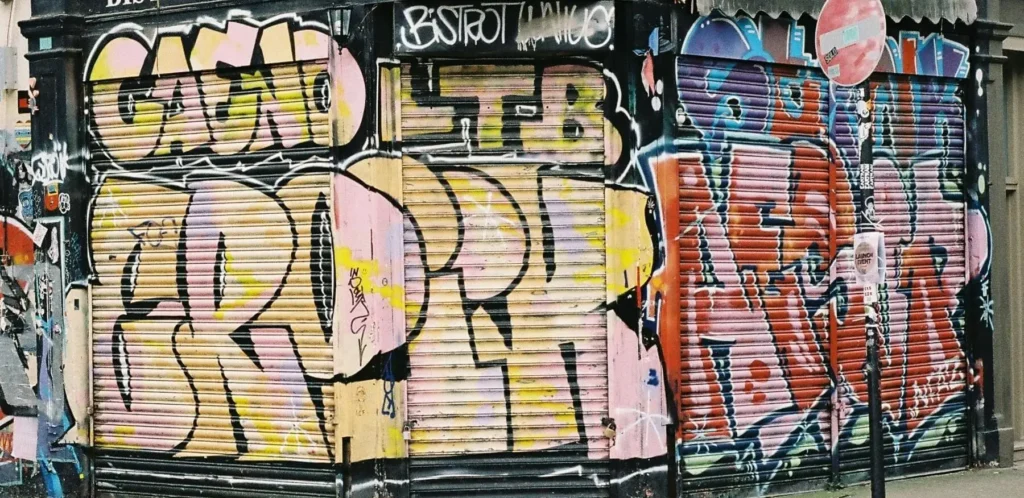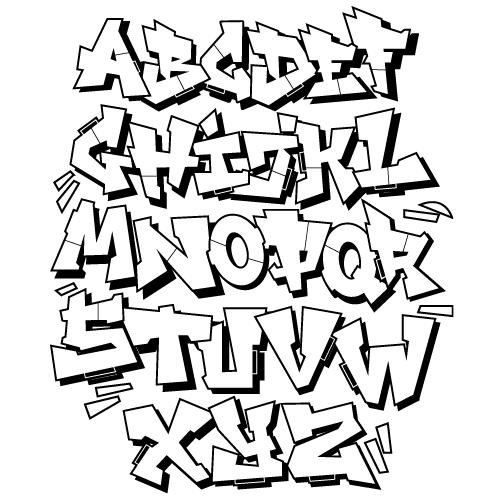Discover the secrets behind creating stunning graffiti old school letters with our comprehensive step-by-step guide. Learn the history, techniques, and tips to elevate your graffiti skills and leave your mark on the world.
Table of Contents
Key Features :
- Bold outlines: Thick, prominent outlines that create visual impact and ensure readability from a distance.
- Stylized lettering: Unique styling such as arrow-like serifs, exaggerated curves, and dynamic angles that add personality to the piece.
- Uniform sizing and spacing: Consistency in letter size and spacing for a cohesive and balanced composition.
- Vibrant color schemes: Bright, eye-catching color combinations, gradients, and patterns that bring the letters to life.
- Connections and flow: Strategic connections and flow between letters using overlapping, underlining, or linking techniques for a seamless design.
Introduction
Graffiti old school letters, also known as « classic » or « vintage » graffiti, have been a cornerstone of the graffiti scene since its inception. These bold, stylized letters not only showcase the artist’s skill but also pay homage to the roots of the graffiti movement. In this article, we’ll dive into the creation process of graffiti old school letters, providing you with the knowledge and techniques to develop your own unique style.

The Essence of Graffiti Old School Letters
Before we delve into the creation process, it’s essential to grasp the key characteristics that define graffiti old school letters. These letters are typically characterized by their thick, bold outlines, often accompanied by arrow-like serifs and a slight lean to the right. The letters are usually uniform in size and spacing, creating a cohesive and balanced composition.
Graffiti old school letters often incorporate vibrant colors and gradients, adding depth and dimension to the piece. The fill-ins, or the interior of the letters, can feature various patterns, such as checkers, stripes, or stars, to enhance the overall visual impact. To learn more about the history and evolution of graffiti old school letters, check out this insightful article by Widewalls.
Planning Your Graffiti Old School Letters
Before putting pen to paper or spray paint to wall, it’s crucial to plan your graffiti old school letters. Start by sketching your design on paper, experimenting with different letter structures, connections, and embellishments. This preliminary sketching phase allows you to refine your concept and ensure a well-balanced composition.
When planning your letters, consider the following aspects:
- Letter structure: Determine the basic shape and style of your letters, whether they’ll be angular, rounded, or a combination of both.
- Connections: Decide how the letters will flow together, using connecting bars or overlapping elements to create a seamless design.
- Embellishments: Incorporate arrows, stars, or other decorative elements to add visual interest and personality to your letters.
- Color scheme: Plan your color palette, considering the use of contrasting colors, gradients, or monochromatic tones to enhance the overall impact of your piece.
For a comprehensive guide on sketching and planning your graffiti letters, visit Bombing Science.
Step-by-Step Guide to Mastering Graffiti Old School Letters
Step 1: Learning the Graffiti Old School Alphabet
The first step in mastering graffiti old school letters is to learn the alphabet. As shown in the image, old school graffiti letters have distinctive characteristics such as thick outlines, arrow-like serifs, and a slight lean to the right. Practice each letter individually, focusing on maintaining consistent size, style, and spacing.

To draw old school graffiti letters, follow these general steps:
- Draw the outline sketches for the letters.
- Add sharp lines for the graffiti designs on the letters.
- Erase the unnecessary lines and draw pointed lines.
- Add shadows to the letter to make it more interesting.

Experiment with different writing tools, such as markers or pens, to find what works best for you.
Practical Tips :
- Begin with simple, straight letters before moving on to more complex styles.
- Use graph paper or create your own guidelines to maintain consistency.
- Practice each letter repeatedly until you can execute it confidently and smoothly.
- Study the works of graffiti old school masters to understand letter structure and style nuances.
Step 2: Adding Style and Flavor to Your Letters
Once you’ve mastered the basic letter structures, it’s time to add style and flavor to your graffiti old school letters. As shown in the attached image, there are several ways to enhance your letters:

Pay attention to the negative space between and within letters. Use this space to add creative details or to create a sense of depth and dimension. Consider incorporating elements like stars, dots, or other geometric shapes to enhance the overall composition.
Ideas for Adding Unique Details:
- Extend the ends of letters with bold, arrow-like serifs.
- Overlap or interlock letters to create a cohesive and dynamic design.
- Use thin lines or accent colors to add depth and dimension to your letters.
- Incorporate patterns or textures within the letter fill-ins for added visual interest.

Step 3: Creating Your Own Graffiti Old School Letter Designs
With a solid understanding of the graffiti old school alphabet and the ability to add unique details, you’re ready to create your own impressive letter designs. Start by sketching out your ideas on paper, exploring different compositions and styles.
As you design your letters, consider the flow and connectivity, balance and hierarchy, color scheme, and background context. Incorporate the tips and techniques you’ve learned in the previous steps to create visually striking and cohesive designs.
Tips for Creating Impressive Pieces:
- Sketch multiple variations of your design to explore different compositions and styles.
- Use reference images of classic graffiti pieces, typography, and graphic design for inspiration.
- Seek feedback from other graffiti artists or join online communities to get constructive critiques and advice.
- Practice, practice, practice! The more you create and refine your designs, the more confident and skilled you’ll become.
Creative Exercises
Explore these two designs, then reinterpret them in your own unique style.

Creative graffiti old school letters exercises
Step 4: Adding Volume to Your Graffiti Old School Letters
To take your graffiti old school letters to the next level, consider adding volume to create a more dynamic and three-dimensional appearance. There are two main techniques for adding volume: using vanishing points or parallel lines.

Two methods to add volume to your old school letters
Method 1 : Using Vanishing Points:
- Choose one or two vanishing points on the horizon line of your piece.
- Draw lines from the corners and edges of your letters towards the vanishing point(s).
- Use these lines as a guide to add depth and perspective to your letters.
- Shade and highlight your letters accordingly to enhance the volumetric effect.
Method 2 : Using Vanishing Points:
- Draw parallel lines on the top, bottom, and sides of your letters.
- Use these lines to create a three-dimensional box around each letter.
- Connect the corresponding corners of the boxes to create the illusion of depth.
- Shade and highlight your letters to emphasize the volumetric appearance.
Experiment with both techniques to find which one works best for your style and composition. You can also combine them to create more complex and interesting volumetric effects.
Frequently Asked Questions (FAQ)
What are the essential tools for creating graffiti old school letters?
Essential tools include a sketchbook, pencils, markers, spray paint, and various nozzles or caps for different effects.
How can I develop my own unique style of old school letters?
Develop your style by mastering fundamentals, experimenting with creative twists, studying influential artists, and embracing trial and error.
What are some legendary old school graffiti artists to study?
Notable old school graffiti pioneers include Phase 2, Blade, Seen, Dondi, Rammellzee, and Zephyr.
How can I practice graffiti old school letters legally and responsibly?
Practice on designated legal walls, obtain permission from property owners, or create artwork on personal property like canvas or wooden panels.
Conclusion
Graffiti old school letters are more than just a style; they represent a rich history and a passionate community of artists. By mastering the art of creating these timeless letters, you’ll not only develop your skills as a graffiti writer but also contribute to the ever-evolving legacy of the graffiti movement.
Remember, the key to success is dedication, patience, and a willingness to learn. Embrace the process, stay true to your artistic vision, and let your graffiti old school letters speak for themselves.
Ready to take your graffiti skills to the next level? Check out our article here and join our thriving community of graffiti enthusiasts.
